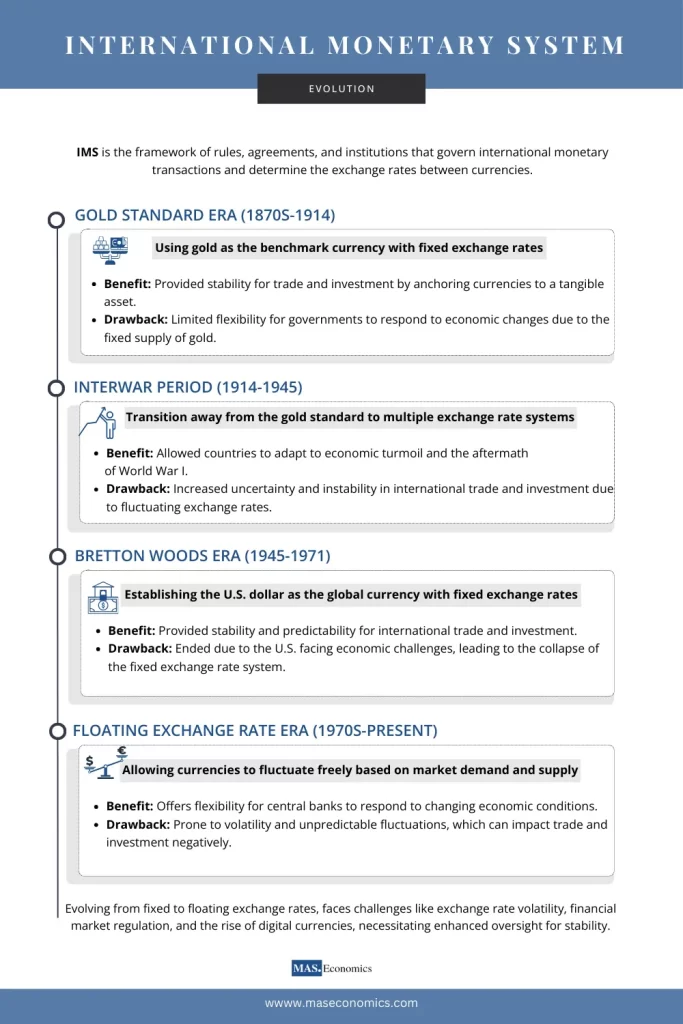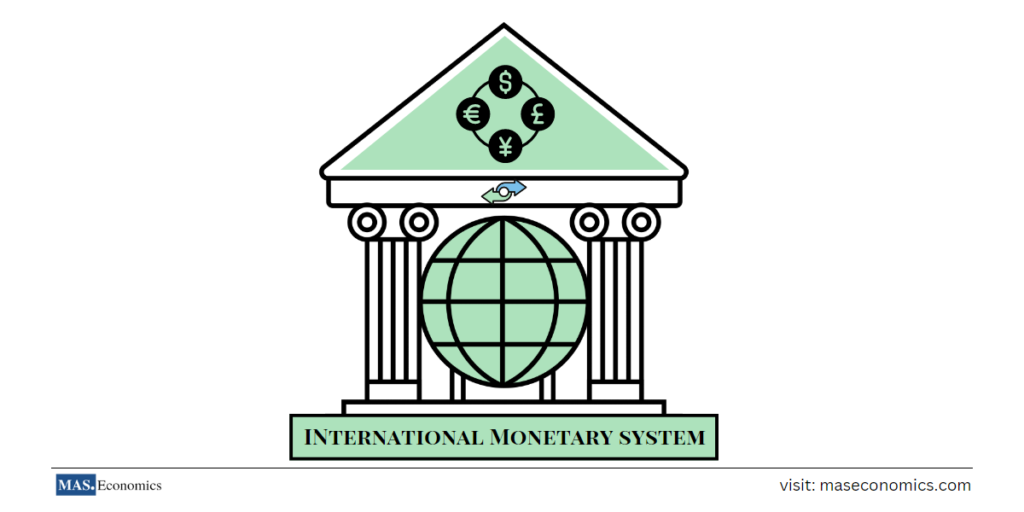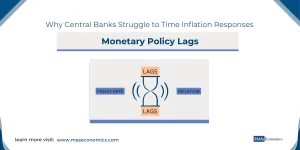The international monetary system is the backbone of the global economy, facilitating currency exchange and determining the relative values of currencies. This system establishes rules and regulations for currency transfers between countries and plays a crucial role in international trade and investment. The global monetary system has undergone significant changes throughout history, evolving from the gold standard to the current floating exchange rate system.
Before we proceed further, let’s take a moment to review the infographic below, offering a brief overview of the evolution of the international monetary system throughout history.

Gold Standard Era (1870s-1914)
The classical gold standard emerged in the 1870s, marking a significant shift in the international monetary system. Under this system, countries fixed the value of their currencies to a specified amount of gold, ensuring stable exchange rates and facilitating international trade. The gold standard provided an automated mechanism for the balance of payments adjustments, as countries with trade deficits experienced outflows of gold. This led to a decrease in the money supply and prices, making their exports more competitive.
However, the gold standard’s rigidity also posed challenges, as countries could not respond to economic shocks and crises. The onset of World War I in 1914 resulted in abandoning the gold standard, as countries needed more flexible monetary policies to finance the war effort.
Interwar Period (1914-1945)
The interwar period was marked by economic instability and failed attempts to restore the gold standard. Following World War I, countries struggled to return to the pre-war gold parities, leading to competitive devaluations and economic turmoil. The Great Depression of the 1930s further exposed the gold standard’s limitations, as countries abandoned gold convertibility to protect their economies.
This period also saw the rise of economic nationalism and protectionist policies as countries sought to insulate themselves from global economic shocks. The lack of international monetary cooperation and the failure of the gold standard paved the way for a new global monetary order.
Bretton Woods Era (1945-1971)
The post-World War II Bretton Woods system was established to promote international monetary cooperation and stability. Under this system, the US dollar became the anchor currency, convertible to gold at a fixed rate of $35 per ounce. Other countries pegged their currencies to the dollar, creating a system of fixed exchange rates.
The Bretton Woods system also led to the creation of critical institutions like the International Monetary Fund (IMF) and the World Bank, designed to provide financial assistance and promote economic development. The IMF played a crucial role in managing the fixed exchange rate system and providing short-term loans to countries facing difficulties with balance of payments.
However, the Bretton Woods system faced mounting pressures in the 1960s amidst rising inflation, economic strain in the US, and a growing balance of payments deficit. The system’s inherent asymmetry, with the US enjoying the advantageous position of issuing the global reserve currency, led to tensions, and ultimately, in 1971, the system collapsed when President Nixon ended dollar convertibility to gold.
Floating Exchange Rate Era (1970s-present)
The 1970s marked the end of the Bretton Woods system of fixed exchange rates and ushered in an era of floating exchange rates determined by market forces of supply and demand. This transition granted countries greater autonomy over monetary policy, as they were no longer constrained by maintaining fixed exchange rates. However, it also introduced increased volatility and uncertainty into the global monetary system.
The European Monetary System (EMS) was established in 1979 to reduce exchange rate variability and promote monetary stability in Europe. This ultimately led to the creation of the euro as a common currency for many European Union member states. The introduction of the euro marked a significant milestone, fostering greater economic integration and stability within the eurozone.
Limitations and Challenges of the Current System
Despite adapting to the global economy’s evolving needs, the floating exchange rate system faces several challenges. Exchange rate volatility can adversely impact trade and investment flows, prompting discussions around potential solutions such as target zones or transaction taxes to curb speculative capital flows. Moreover, periodic financial crises, such as the Latin American debt crisis of the 1980s, the Asian financial crisis of the late 1990s, and the 2008 global financial crisis, have exposed vulnerabilities within the international monetary system.
In response, institutions like the IMF have adapted their roles to provide surveillance, policy advice, and financial assistance to needy countries. The IMF also supplies objective indicators to guide nations’ macroeconomic policies. Additionally, the rise of emerging economies, notably China, has shifted the balance of economic power, leading to calls for better representation in global financial governance bodies.
These crises have underscored the need for improved regulation, oversight of financial markets, and increased transparency in international monetary relations. Promoting private sector involvement and reducing emerging market economies’ vulnerability to financial instability remain crucial tasks in strengthening the international monetary system.
The Future: Digital Currencies and Beyond
As the world enters the digital age, the international monetary system is poised for further transformation. The rise of digital currencies, such as Bitcoin and central bank digital currencies (CBDCs), presents both opportunities and challenges for the global monetary order.
Digital currencies offer the potential for faster, cheaper, and more inclusive cross-border payments, reducing the reliance on traditional intermediaries. However, they also raise concerns about monetary sovereignty, financial stability, and the role of central banks in the digital era.
The international monetary system must adapt to new realities as the global economy becomes increasingly interconnected and digitized. This may have a more significant role in regional financial arrangements, such as the European Monetary Union or the Chiang Mai Initiative, as well as increased cooperation between central banks and international organizations.
Conclusion
The evolution of the international monetary system has profoundly shaped global economic relations. From the Gold Standard Era to the current floating exchange rate system, each phase has responded to the global economy’s unique needs and challenges. While the current system offers many advantages, it also faces significant issues that must be addressed to ensure stability and promote security in international trade and investment. Cooperation among countries is essential to finding solutions and safeguarding global markets from financial shocks.
FAQs:
What is the international monetary system?
The international monetary system consists of rules, institutions, and mechanisms that facilitate currency exchange between countries. It determines how exchange rates are set and governs international trade, investments, and financial transactions. It plays a crucial role in stabilizing the global economy.
What was the Gold Standard?
The Gold Standard was a monetary system in which countries fixed the value of their currency to a specific amount of gold. This system, prevalent from the 1870s to 1914, ensured stable exchange rates, facilitating international trade. However, it limited countries’ ability to adjust monetary policy during economic shocks, leading to its abandonment during World War I.
Why did the Gold Standard collapse?
The Gold Standard collapsed during World War I because countries needed more flexible monetary policies to finance war efforts. Attempts to return to the gold standard in the interwar period were unsuccessful due to economic instability and the Great Depression, leading to its eventual abandonment.
What was the Bretton Woods system?
The Bretton Woods system, established after World War II, pegged currencies to the US dollar, which was convertible to gold at $35 per ounce. It aimed to promote global economic stability through fixed exchange rates and led to the creation of institutions like the International Monetary Fund (IMF) and World Bank. It lasted until 1971 when the US ended gold convertibility, marking its collapse.
Why did the Bretton Woods system end?
The Bretton Woods system collapsed due to mounting pressures, including rising inflation in the US, a growing balance of payments deficit, and an overvalued dollar. In 1971, President Nixon suspended dollar convertibility to gold, leading to the transition to floating exchange rates.
What are floating exchange rates?
Floating exchange rates are determined by market forces of supply and demand rather than being fixed to another currency or commodity. This system, which began in the 1970s, allows countries greater autonomy over monetary policy but introduces more exchange rate volatility.
What are some challenges of the floating exchange rate system?
Challenges include exchange rate volatility, which can impact trade and investment, and the occurrence of financial crises, such as the Latin American debt crisis, the Asian financial crisis, and the 2008 global financial crisis. These events have highlighted the need for stronger financial regulation and international cooperation.
How has the role of the IMF evolved?
The IMF’s role has expanded from managing fixed exchange rates under the Bretton Woods system to providing policy advice, surveillance, and financial assistance to countries facing economic challenges. It also supports macroeconomic stability by guiding countries through financial crises and offering recommendations on policy reforms.
What role do digital currencies play in the international monetary system?
Digital currencies, including cryptocurrencies like Bitcoin and central bank digital currencies (CBDCs), offer faster and cheaper cross-border payments. They have the potential to reshape the international monetary system by reducing reliance on traditional intermediaries. However, they pose challenges like maintaining monetary sovereignty and ensuring financial stability.
What is the future of the international monetary system?
The future of the international monetary system may involve increased regional financial cooperation, adaptation to digital currencies, and a greater role for emerging economies like China in global financial governance. Addressing challenges such as financial instability and promoting transparency remain crucial for stability in the global economy.
Thanks for reading! If you found this history of the Evolution of the International Monetary System helpful, share the knowledge with friends and spread it on social media!
Happy learning with MASEconomics




